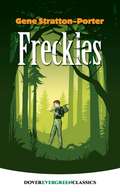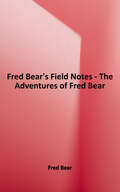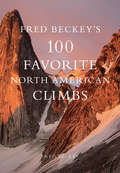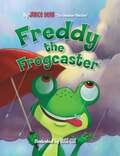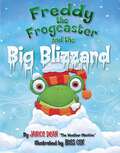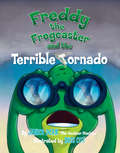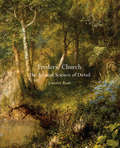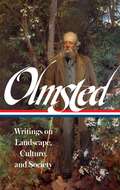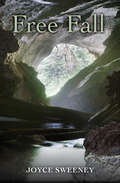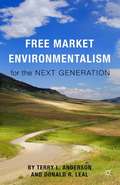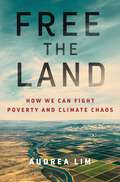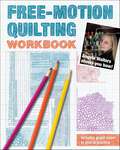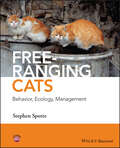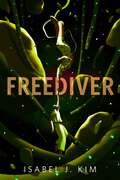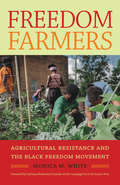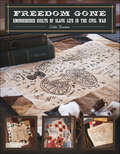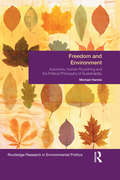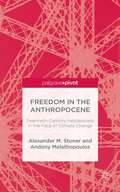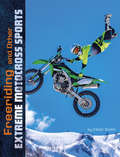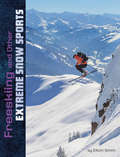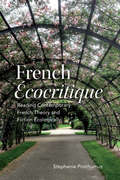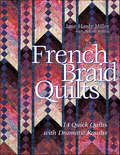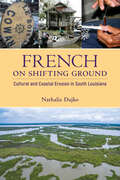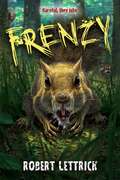- Table View
- List View
Freckles
by Gene Stratton-PorterIn this companion book to the much-loved classic A Girl of the Limberlost, an orphaned teenager longs to find his place in the world. Freckles was discovered on the doorstep of a Chicago orphanage, badly beaten and missing a hand. He yearns for the fulfillment of useful work, and at Indiana's Limberlost Swamp, his grit and determination win him the difficult, dangerous job of guarding a valuable stand of timber. Faithful and brave in his daily tasks, Freckles comes to appreciate the beauty and majesty of the natural world amid the wetlands' sights, sounds, and silences.As nature works miracles in the boy's lonely, starved heart, Freckles meets a kind and gentle girl who collects specimens for a wildlife photographer. Despite his growing love for his Swamp Angel, Freckles feels himself far below her station — until the opportunity arises for him to prove his true worth.
Fred Bear's Field Notes: The Adventures of Fred Bear
by Fred BearA classic collection of Fred Bear's hunts and adventures. Fred Bear is known for being one of the most popular and successful outdoorsmen to date. His passion and skill for archery led him to create the successful Bear Archery company. In Fred Bear's Field Notes: The Adventures of Fred Bear, Fred Bear shares all of his personal reflections and field notes in this great 288-page book. 100 photos capture his international hunting expeditions.
Fred Beckey's 100 Favorite North American Climbs
by Barry BlanchardFred Beckey's 100 Favorite North American Climbs is the magnum opus of the greatest American climber of the past century. Fred's intimate, detailed knowledge of the mountains and climbs he chronicles here create an unparalleled guidebook and must-have for every climber's bookshelf - as well as a great read for any armchair adventurer. Filled with hand-drawn climbing topos, photos, narrative description, side notes and 40 extra climbs of note in each of the eight geographical regions. This is the guide for every climber's bookshelf.
Freddy the Frogcaster
by Janice DeanFreddy the Frog loves learning about the weather, and he's known for having the best predictions in town. But what happens when the town picnic is almost ruined by a storm that catches the local frogcaster by surprise? Freddie has to step in to save the day! Well-known Fox News broadcast meteorologist Janice Dean pens this exciting and hilarious tale about an aspiring weathercaster who can't keep his eyes off the sky. Children and adults will love the charming frog world Freddy lives in, and the fun science lessons he shares, with an activities section in the back
Freddy the Frogcaster and the Big Blizzard
by Janice DeanFreddy the Frog loves learning about the weather, and he’s known for having the best predictions in town. But what happens when a blizzard rolls in?
Freddy the Frogcaster and the Terrible Tornado
by Janice DeanGet ready for a whirlwind of adventure with Freddy the Frogcaster when a famous storm chaser visits Lilypad! In her fourth book, well-known meteorologist Janice Dean tackles some scary weather. Freddy the Frogcaster is faced with one of the most ferocious and devastating kinds of weather: the tornado. Young readers will learn all about how big storms occur and produce some of nature's most destructive weather. Chock-full of storm science lessons in the back, children and adults alike will learn valuable life-saving information. As Freddy reminds us, please be prepared and know what to do and where to go when the next bad storm comes your way! <p><p> <i>Advisory: Bookshare has learned that this book offers only partial accessibility. We have kept it in the collection because it is useful for some of our members. To explore further access options with us, please contact us through the Book Quality link on the right sidebar. Benetech is actively working on projects to improve accessibility issues such as these. </i>
Frederic Church
by Jennifer RaabFrederic Church (1826-1900), the most celebrated painter in the United States during the mid-19th century, created monumental landscapes of North and South America, the Arctic, and the Middle East. These paintings were unsurpassed in their attention to detail, yet the significance of this pictorial approach has remained largely unexplored. In this important reconsideration of Church's works, Jennifer Raab offers the first sustained examination of the aesthetics of detail that fundamentally shaped 19th-century American landscape painting. Moving between historical context and close readings of famous canvases--including Niagara, The Heart of the Andes, and The Icebergs--Raab argues that Church's art challenged an earlier model of painting based on symbolic unity, revealing a representation of nature with surprising connections to scientific discourses of the time. The book traces Church's movement away from working in oil on canvas to shaping the physical landscape of Olana, his self-designed estate on the Hudson River, a move that allowed the artist to rethink scale and process while also engaging with pressing ecological questions. Beautifully illustrated with dramatic spreads and striking details of Church's works, Frederic Church: The Art and Science of Detail offers a profoundly new understanding of this canonical artist.
Frederick Law Olmsted: Writings on Landscape, Culture, and Society
by Frederick Law Olmsted Charles BeveridgeThe biggest and best single-volume collection ever published of the fascinating and wide-ranging writings of a vitally important nineteenth century cultural figure whose work continues to shape our world today. Seaman, farmer, abolitionist, journalist, administrator, reformer, conservationist, and without question America's foremost landscape architect and urban planner, Frederick Law Olmsted (1822-1903) was a man of unusually diverse talents and interests, and the arc of his life and writings traces the most significant developments of nineteenth century American history. As this volume reveals, the wide-ranging endeavors Olmsted was involved in--cofounding The Nation magazine, advocating against slavery, serving as executive secretary to the United States Sanitary Commission (precursor to the Red Cross) during the Civil War, championing the preservation of America's great wild places at Yosemite and Yellowstone--emerged from his steadfast commitment to what he called "communitiveness," the impulse to serve the needs of one's fellow citizens. This philosophy had its ultimate expression is his brilliant designs for some of the country's most beloved public spaces: New York's Central Park, Prospect Park in Brooklyn, Boston's "Emerald Necklace," the Biltmore Estate in North Carolina, the grounds of the U.S. Capitol, garden suburbs like Chicago's Riverside, parkways (a term he invented) and college campuses, the "White City" of the 1893 World's Columbian Exposition, and many others. Gathering almost 100 original letters, newspaper dispatches, travel sketches, essays, editorials, design proposals, official reports, reflections on aesthetics, and autobiographical reminiscences, this deluxe Library of America volume is profusely illustrated with a 32-page color portfolio of Olmsted's design sketches, architectural plans, and contemporary photographs. It also includes detailed explanatory notes and a chronology of Olmsted's life and design projects.From the Hardcover edition.
Free Fall
by Joyce SweeneyWhen four boys decide to spend the day exploring a cave, they have no idea that their fun afternoon is about to become a fight for survival Neil and his best friend, Randy, can't wait to explore a nearby cave for the afternoon. But when Neil's little brother, David, finds out, Neil is forced to bring David and his timid friend Terry along for the ride. What starts out as an exciting expedition soon turns dangerous when the four boys get lost in the cave's labyrinth of winding passages. Neil knows it's not David's fault that they're lost, yet he still lashes out at his brother with every wrong turn, and Randy and David's constant bickering isn't helping to calm his nerves. As tension builds between the boys, Neil and David try to address what they've kept hidden for years: the truth about David that can never be forgotten--or forgiven. Hopelessly lost, angry, hungry, and terrified, the boys are willing to do just about anything to find a way out of the cave before they end up killing one another. But to escape, Neil and David are going to have to figure out a way to put the past behind them and work together.
Free Market Environmentalism for the Next Generation
by Terry L. Anderson Donald R. LealThis book provides a vision for environmentalism's future, based on the success of environmental entrepreneurs around the world. The work provides the next generation of environmental market ideas and the chapters are co-authored with young scholars and policy analysts who represent the next generation of environmental leaders.
Free Spirit
by David RookFrom the Book jacket: He was extraordinary. He was the Fox who gloried in the hunt, the Fox who couldn't be caught! Tag knew more tricks than a dozen foxes put together. He could give them a hunt that made every heart beat wild. And for good reason. He had been reared in Asher's kennels, raised with Asher's own foxhounds. Tag's antics made the Belstone Hunt a legend. His bond with the dog named Merlin made that runt of the litter into leader of the pack. Until suddenly sport turned to tragedy. Asher swore revenge. The game was over. His hounds were hot on the trail, teeth bared for the kill.
Free the Land: How We Can Fight Poverty and Climate Chaos
by Audrea LimAn eye-opening examination of how treating land as a source of profit has a massive impact on racial inequality and the housing, gentrification, and environmental crises.Climate change, gentrification, racial inequity, and corporate greed are some of the most urgent problems facing our society. They are traditionally treated as unrelated issues, but they all share a common root: the commodification of land. Environmental journalist Audrea Lim began to notice these connections a decade ago when she reported on the Native communities leading the fight against oil mining on their lands in the Canadian tar sands near her hometown of Calgary, but before long, she saw the essential role of land commodification and private ownership everywhere she looked: in foreclosure-racked suburbs and gentrifying cities like New York City; among poor, small farmers struggling to keep their businesses afloat; and in low-income communities attempting to resist mines and industrial development on their lands, only to find that their voices counted less than those of shareholders living thousands of miles away.Free The Land is a captivating and beautifully rendered look at the ways that our relationship to the land is the core cause of the most pressing justice issues in North America. Lim expertly weaves together seemingly disparate themes into a unified theory of social justice, describes how the land ownership system developed over the centuries, and presents original reporting from a wide range of activists and policy makers to illustrate the profound impact it continues to have on our society today.Ultimately, this book offers a message of hope: by approaching these socioeconomic issues holistically, we can begin to imagine just alternatives to fossil-fueled capitalism, new ways to build community, and a more sustainable, equitable world.
Free-Motion Quilting Workbook: Angela Walters Shows You How!
by Angela WaltersIf you can sketch it, you can stitch it! The master of free-motion quilting teaches you everything you need to know in this hands-on workbook! • The master of free-motion quilting, Angela Walters, teaches you everything you need to know • Just doodle and have fun! Not your typical how-to manual - this guided sketchbook will train your brain to understand how designs flow and will ultimately make you a better quilter! • Practice sketching in a variety of different shapes to represent the different sections of a quilt, including blocks, borders, and negative space If you can sketch it, you can stitch it. Inside this interactive workbook, professional quilter, Angela Walters, shows you how to plan and practice free-motion quilting. Guided by her expert tips and suggestions, your creative juices will flow as you doodle designs of entire quilts, individual blocks, borders, and even negative space. The workbook pages have plenty of line-art shapes and inspiring photographs to help get you started. There’s also a bonus section of graph paper to plan your own quilt designs. So, go ahead, start sketching!
Free-ranging Cats
by Stephen SpotteFeral and stray domestic cats occupy many different habitats. They can resist dehydration for months by relying exclusively on the tissue water of their prey allowing them to colonize remote deserts and other inhospitable places. They thrive and reproduce in humid equatorial rainforests and windswept subantarctic islands. In many areas of the world feral cats have driven some species of birds and mammals to extinction and others to the edge, becoming a huge conservation concern. With the control of feral and stray cats now a top conservation priority, biologists are intensifying efforts to understand cat behaviour, reproductive biology, use of space, intraspecies interaction, dietary requirements, prey preferences, and vulnerability to different management strategies. This book provides the most comprehensive review yet published on the behavior, ecology and management of free-ranging domestic cats, whether they be owned, stray, or feral. It reviews management methods and their progress, and questions several widely accepted views of free-ranging cats, notably that they live within dominance hierarchies and are highly social. Insightful and objective, this book includes: a functional approach, emphasizing sensory biology, reproductive physiology, nutrition, and space partitioning; clear treatment of how free-ranging cats should be managed; extensive critical interpretation of the world's existing literature; results of studies of cats in laboratories under controlled conditions, with data that can also be applied to pet cats. Free-ranging Cats: Behavior, Ecology, Management is valuable to ecologists, conservation scientists, animal behaviorists, wildlife nutritionists, wildlife biologists, research and wildlife veterinarians, clinical veterinarians, mammalogists, and park and game reserve planners and administrators.
Freediver: A Tor Original
by Isabel J. KimA two-man team must risk a spacewalk when meteoroids threaten crucial portal-spanning telecommunications cables that hang a hundred meters beneath the ocean...and forty-five billion light years away.At the Publisher's request, this title is being sold without Digital Rights Management Software (DRM) applied.
Freedom Farmers: Agricultural Resistance and the Black Freedom Movement (Justice, Power, and Politics)
by Monica M. WhiteIn May 1967, internationally renowned activist Fannie Lou Hamer purchased forty acres of land in the Mississippi Delta, launching the Freedom Farms Cooperative (FFC). A community-based rural and economic development project, FFC would grow to over 600 acres, offering a means for local sharecroppers, tenant farmers, and domestic workers to pursue community wellness, self-reliance, and political resistance. Life on the cooperative farm presented an alternative to the second wave of northern migration by African Americans--an opportunity to stay in the South, live off the land, and create a healthy community based upon building an alternative food system as a cooperative and collective effort.Freedom Farmers expands the historical narrative of the black freedom struggle to embrace the work, roles, and contributions of southern black farmers and the organizations they formed. Whereas existing scholarship generally views agriculture as a site of oppression and exploitation of black people, this book reveals agriculture as a site of resistance and provides a historical foundation that adds meaning and context to current conversations around the resurgence of food justice/sovereignty movements in urban spaces like Detroit, Chicago, Milwaukee, New York City, and New Orleans.
Freedom Gone: Embroidered Quilts of Slave Life in the Civil War
by Lolita NewmanLolita Newman’s search to find her family connection with slavery moved her to create heirlooms linking her past to the present. She started Stitchin’ by the River Studio, a nod to her Cane River, La., roots. Her Freedom Gone quilts are rich in color and history. They depict slavery during the Civil War years, using images in black thread. The seven quilts and six projects bring past stories to life, showing common chores, family life, and slave quarters — and the quest for freedom. She hopes that these depictions warm your heart and stir your soul. Learn more about the Civil War era with an informative introduction for each quilt project Create 7 geometric quilts and 6 home decor and accessory projects designed by Lolita Newman Stitch various scenes and figures with black floss with helpful tips throughout the way
Freedom and Environment: Autonomy, Human Flourishing and the Political Philosophy of Sustainability (Environmental Politics)
by Michael HannisMust freedom be sacrificed to achieve ecological sustainability - or vice versa? Can we be genuinely free and live in sustainable societies? This book argues that we can, if we recognise and celebrate our ecological embeddedness, rather than seeking to transcend it. But this does not mean freedom can simply be redefined to fit within ecological limits. Addressing current unsustainability will involve significant restrictions, and hence will require political justification, not just scientific evidence. Drawing on material from perfectionist liberalism, capabilities approaches, human rights, relational ethics and virtue theory, Michael Hannis explores the relationship between freedom and sustainability, considering how each contributes to human flourishing. He argues that a substantive and ecologically literate conception of human flourishing can underpin both capability-based environmental rights and a eudaimonist ecological virtue ethics. With such a foundation in place, public authorities can act both to facilitate ecological virtue, and to remove structural incentives to ecological vice. Freedom and Environment is a lucid addition to existing literature in environmental politics and virtue ethics, and will be an excellent resource to those studying debates about freedom with debates about ecological sustainability.
Freedom in the Anthropocene: Twentieth-Century Helplessness in the Face of Climate Change
by Alexander M. Stoner Andony MelathopoulosFreedom in the Anthropocene illuminates the Anthropocene from the perspective of critical theory. The authors contextualize our current ecological predicament by focusing on the issues of history and freedom and how they relate to our present inability to render environmental threats and degradation recognizable and surmountable.
Freeriding and Other Extreme Motocross Sports (Natural Thrills)
by Elliott SmithCheck out the fast sport of freeriding! Learn about freeriding, how it started, equipment needed, and safety measures taken for this extreme sport. Discover other motocross sports, and find out how athletes practice their skills and experience thrills in nature.
Freeskiing and Other Extreme Snow Sports (Natural Thrills)
by Elliott SmithBundle up and follow the frosty world of freeskiing. Learn about freeskiing, equipment needed, and safety measures taken for this extreme sport. Discover other snow sports, and see how athletes practice their skills and experience thrills in nature.
French 'Ecocritique': Reading French Theory and Fiction Ecologically
by Stephanie PosthumusFrench Écocritique is the first book-length study of the culturally specific ways in which contemporary French literature and theory raise questions about nature and environment. Stephanie Posthumus’s ground-breaking work brings together thinkers such as Guattari, Latour, and Serres with recent ecocritical theories to complicate what might otherwise become a reductive notion of "French ecocriticism." Working across contemporary philosophy and literature, the book defines the concept of the ecological as an attentiveness to specific nature-culture contexts and to a text’s many interdiscursive connections. Posthumus identifies four key concepts, ecological subjectivity, ecological dwelling, ecological politics, and ecological ends, for changing how we think about human-nature relations. French Écocritique highlights the importance of moving beyond canonical ecocritical texts and examining a diversity of cultural and literary traditions for new ways of imagining the environment.
French Braid Quilts: 14 Quick Quilts with Dramatic Results
by Jane Hardy Miller Arlene NettenSimple Piecing - Spectacular Quilts • One great technique, a variety of different looks! • LEARN TO USE VALUE: Create glowing effects by choosing a gradated range of fabrics. • Super-easy piecing means fast quilt construction • Make it yours with pretty borders, separator bands, and other creative variations Color is key when you "braid" a variety of fabrics into an eye-catching quilt. Learn to identify value in fabric and use it to create the effect you want-in these quilts and every quilt you make! Fourteen projects range from striking wall hangings to bed quilts.
French on Shifting Ground: Cultural and Coastal Erosion in South Louisiana (America's Third Coast Series)
by Nathalie DajkoIn French on Shifting Ground: Cultural and Coastal Erosion in South Louisiana, Nathalie Dajko introduces readers to the lower Lafourche Basin, Louisiana, where the land, a language, and a way of life are at risk due to climate change, environmental disaster, and coastal erosion. Louisiana French is endangered all around the state, but in the lower Lafourche Basin the shift to English is accompanied by the equally rapid disappearance of the land on which its speakers live. French on Shifting Ground allows both scholars and the general public to get an overview of how rich and diverse the French language in Louisiana is, and serves as a key reminder that Louisiana serves as a prime repository for Native and heritage languages, ranking among the strongest preservation regions in the southern and eastern US. Nathalie Dajko outlines the development of French in the region, highlighting the features that make it unique in the world and including the first published comparison of the way it is spoken by the local American Indian and Cajun populations. She then weaves together evidence from multiple lines of linguistic research, years of extensive participant observation, and personal narratives from the residents themselves to illustrate the ways in which language—in this case French—is as fundamental to the creation of place as is the physical landscape. It is a story at once scholarly and personal: the loss of the land and the concomitant loss of the language have implications for the academic community as well as for the people whose cultures—and identities—are literally at stake.
Frenzy
by Robert LettrickCamp Harmony. A place to relax, swim in the river, and stage epic water fights. A time to escape and admire the outdoors. That was how Heath Lambert wanted to spend his summer. But nobody told him that he would spend it running for his life. Almost every animal in the surrounding forest-thousands of them, from squirrels to wolves-has gone on the attack. Even the camp's horses! If Heath and his friends are to stay alive, they have only one place to go. But getting there is just half the battle.
